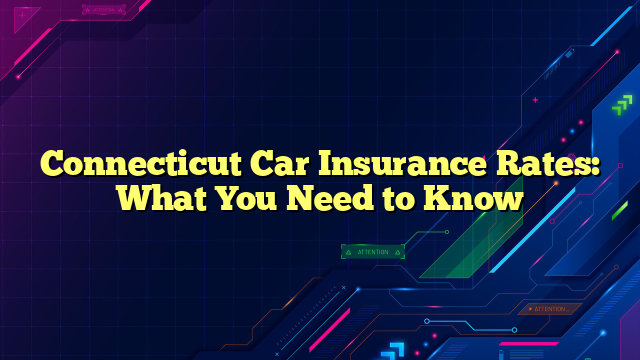The Basics of Connecticut Car Insurance Rates
Hello PortalSindo Friend! If you’re a driver in Connecticut, you know that car insurance rates can be a significant expense. Understanding how these rates are calculated can help you make informed decisions about your coverage. In this article, we’ll explore the ins and outs of Connecticut car insurance rates, from the factors that affect them to the strengths and weaknesses of the system. Let’s get started!
Factors That Affect Connecticut Car Insurance Rates
Several factors contribute to the calculation of car insurance rates in Connecticut. These include:
| Factor | Explanation |
|---|---|
| Driving Record | Drivers with a history of accidents or traffic violations are considered higher risk and may pay more for insurance. |
| Location | Drivers in urban areas or areas with high rates of accidents or theft may pay more for insurance. |
| Age and Gender | Younger drivers and male drivers are considered higher risk and may pay more for insurance. |
| Type of Vehicle | Cars with higher values or that are more expensive to repair may cost more to insure. |
| Credit Score | Drivers with lower credit scores may pay more for insurance. |
| Driving Habits | Drivers who use their cars for business purposes or who have long commutes may pay more for insurance. |
Strengths of Connecticut Car Insurance Rates
There are some strengths to Connecticut’s car insurance rate system:
1. Regulated Industry
Connecticut’s insurance industry is regulated by the state, which helps to protect consumers from unfair practices and ensures that rates are reasonable and fair.
2. Competitive Market
Connecticut has a competitive insurance market, which means that drivers have a wide range of options when it comes to choosing a policy. This can help keep rates reasonable.
3. Discounts and Incentives
Many insurance companies offer discounts and incentives to drivers who take certain actions, such as completing a defensive driving course or installing safety features in their cars.
4. No-Fault Insurance
Connecticut is a no-fault insurance state, which means that drivers are required to carry insurance that covers their own injuries in the event of an accident. This can help streamline the claims process and reduce litigation.
5. Tort System
Connecticut operates under a tort system, which means that drivers who are found to be at fault in an accident are responsible for paying for damages. This can help keep rates lower by reducing insurance companies’ exposure to risk.
6. Minimum Coverage Requirements
Connecticut requires drivers to carry a minimum amount of liability insurance, which helps to ensure that all drivers are protected in case of an accident.
Weaknesses of Connecticut Car Insurance Rates
However, there are also some weaknesses to the Connecticut car insurance rate system:
1. High Rates
Connecticut has some of the highest car insurance rates in the country, which can make it difficult for some drivers to afford coverage.
2. Limited Coverage Options
While Connecticut does have a competitive insurance market, some drivers may find that certain types of coverage are limited or unavailable.
3. No Guaranteed Rate Reductions
While drivers may be able to take steps to reduce their rates, such as improving their credit score or driving record, there are no guaranteed rate reductions or rate freezes.
4. Limited Consumer Education
Many drivers may not fully understand how car insurance rates are calculated or what options are available to them, which can make it difficult to make informed decisions about coverage.
5. No Statewide Rate Cap
Unlike some states, Connecticut does not have a statewide rate cap, which means that insurance companies may be able to charge higher rates without restriction.
6. No Guaranteed Coverage
While Connecticut requires drivers to carry a certain amount of insurance, there is no guarantee that all drivers will be able to find affordable coverage that meets their needs.
Frequently Asked Questions
1. What is the minimum amount of car insurance required in Connecticut?
Connecticut requires drivers to carry liability insurance with a minimum of $25,000 per person and $50,000 per accident for bodily injury, as well as $25,000 for property damage.
2. Is it possible to get car insurance with a bad driving record in Connecticut?
While drivers with a bad driving record may face higher rates, it is still possible to find coverage in Connecticut. Drivers may want to consider working with an insurance agent or shopping around for quotes to find the best rate.
3. Are there any discounts available for car insurance in Connecticut?
Many insurance companies offer discounts and incentives to drivers who take certain actions, such as completing a defensive driving course or installing safety features in their cars. Drivers may want to ask their insurance company about available discounts.
4. What is the difference between collision and comprehensive coverage?
Collision coverage covers damage to your car in the event of an accident, while comprehensive coverage covers damage to your car from non-collision events, such as theft or weather damage.
5. What should I do if I can’t afford car insurance in Connecticut?
If you are unable to afford car insurance in Connecticut, you may want to consider other options, such as using public transportation or carpooling. You may also be eligible for state-sponsored insurance programs.
6. What should I do if I am involved in a car accident in Connecticut?
If you are involved in a car accident in Connecticut, you should exchange insurance information with the other driver and contact your insurance company as soon as possible. You may also want to file a police report and seek medical attention if necessary.
7. How can I reduce my car insurance rates in Connecticut?
There are several steps you can take to reduce your car insurance rates in Connecticut, such as improving your credit score, taking a defensive driving course, or increasing your deductible. You may also want to shop around for quotes from different insurance companies.
Take Action Now!
Now that you know more about Connecticut car insurance rates, it’s time to take action! Start by reviewing your current coverage to see if there are any areas where you could save money. Consider taking steps to improve your driving record or credit score, and shop around for quotes from different insurance companies to find the best rate. Remember, informed decisions lead to better outcomes!
Disclaimer
The information contained in this article is for general informational purposes only and is not a substitute for professional advice. PortalSindo and its affiliates cannot be held liable for any damages arising from the use of this information.






